Determining Information Security Threats for an IoT-Based Energy Internet by Adopting Software Engineering and Risk Management Approaches
Abstract
1. Introduction
2. Literature Review
2.1. Threat Model
2.2. Smart Grid (SG)
2.3. SG Information Security Threats
2.4. Risk Management
2.5. Review Findings
- Although the DFD is a commonly used design tool, and is good at describing processes, data, and their interrelationships, the implementation of DFD should consider other supporting tools for analyzing large-scale information systems because the number of external entities and processes will increase the quantity of data flows, making the whole DFD implementation more complex. In other words, if there is no necessary confirmation or screening support, the subsequent ISTM process will be too divergent, and not easily focused.
- The well-known categorization schemes for threat types, whether LINDDUN or STRIDE, are useful tools capable of listing threat types through accessing DFDs. However, different schemes cover different threat types—whether it is possible combine their advantages into a single scheme is an interesting issue.
- Tools such as STRIDE can be used to analyze the DFD component in order to map the corresponding threat type but are incapable of determining more detailed IST items. In addition to introducing expert opinions (mostly using the Delphi method which is a well-known communication technique widely used for forecasting through an iterative process with a panel of experts [51,52,53] and is also a useful means of determining key factors, especially those with uncertainty [54]), the ISTM operation should consider referring to a topic-related RBS as an objective basis for discussion and corresponding ISTs.
- When assessing ISTs for a system that contains a large number of functional components, as well as a variety of applications, it can be assumed that the number of ISTM outputs, i.e., ISTs, will be large. On the other hand, if the available resources are not sufficient to respond to all the ISTs, the way in which key ISTs are evaluated and screened for subsequent disposal is a practical problem that must be attended to. Moreover, the question of how to make a suitable arrangement between subjective expert opinions and objective information to avoid the bias of expert opinions is also an essential problem that should be solved.
3. Proposed I-SERM ISTM Approach
3.1. I-SERM Process
- Identify the functional components of the target sensor system: This step performs a literature search to retrieve functional components of the target system. The result of the literature search is presented in the form of a product flow diagram (PFD), which is useful for describing the relative positions of the components and the production flows of the outputs. If required for further discussion, the definition of the involved components should be noted.
- Analyze use cases of applications and their relationships: This step analyzes application cases and their relationships according to application requirements by referring to the associated functional components denoted in the PFD. Then, it transforms the selected application cases into a Subject, Verb, Object (S+V+O) pattern to clearly present the application cases. Next, it depicts a use case diagram (UCD).
- Functional decomposition on the use cases: The purpose of this step is to detail the operation paths, including the exception path for each case. The methods for detailing the operation paths are scenario description and interface design by blueprint. The above functional decompositions with detailed descriptions are the essential basis for generating further DFDs.
- Determine the threat types of each DFD element: This step determines threat types by analyzing the DFD components (including external entities, data flow, data storage, and processes) corresponding to STRIDE+p (introduced in the next sub-section).
- Identify ISTs by using TBS+r: A TBS+r is a pre-defined threat breakdown structure for use as a reference when listing the possible ISTs for each DFD element.
- Assess ISTs by referring to TBS+r scores: In this step, experts in the field of the target system or information security theories are invited to help confirm key ISTs. The well-known Delphi method is suggested for the process of prioritizing ISTs by assessing their impact and likelihood. By using an iterative Delphi process with anonymous scoring, open discussion, and result confirmation, this step can be completed when the pre-defined criteria are met, and the process can proceed to the next step. Otherwise, the process should go back to Step 5 to recheck the ISTs, or even identify further possible ISTs that merit concern.
- Confirm key ISTs for the planned application: This step confirms the key ISTs, and creates the final ISTM in a proper form, for example, a threat tree.
3.2. STRIDE+p Matrix
3.3. TBS+r Scheme
3.4. Threat Assessment Mechanism
4. Demonstration of an I-SERM Practice: SG Electricity Load Balance
4.1. Identifying the Functional Components of the Target Sensor System
4.2. Steps 2 to 7 of the I-SERM
5. Conclusions
- The maintenance of the content of TBS+r. A key feature of I-SERM is applying TBS+r in a Delphi process in order to enhance the performance of the ISTM operation. In addition, the success of I-SERM should also rely on the IST scoring by the participating experts, while their feedback will be associated with the referred TBS+r. In other words, the content of TBS+r will significantly affect the ISTM result. As similar as the importance of maintaining updated rules for firewalls, intrusion detection systems (IDS) or intrusion prevention systems (IPS), the TBS+r must be kept up to date.
- The use of multi-dimensional analysis. In practice, the use of a single-dimensional perspective is illogical for assessing target factors. In this ELB case, the ratio of |PW|:|IW| set as = 1:1 is the only perspective for selecting key ISTs. Different |PW|:|IW| ratios should deliver different viewpoints of the selection. That is, a multi-dimensional analysis method could improve the reliability and validity of a study. For this issue, the Theoretical Triangulation approach [59,60,61] could be considered in future work.
- The suggested IST action-list. The I-SERM outputs are key ISTs that should be carefully considered in designing and implementing application functions. Unfortunately, the I-SERM cannot provide appropriate actions for these selected key ISTs. In fact, since the TBS+r can be used as a reference to help determine ISTs and prioritize key ISTs, it is reasonable to create an action-list scheme that may identify the initiatives to protect against any specific IST.
- A complete ISTM for the Energy Internet. In this study, only one simple practice, ELB, is considered. This practice demonstrates the usability of the I-SERM but is limited in terms of presenting a complete ISTM for the IoT-based Energy Internet. In the future, more complex and innovative SG applications, such as Time-of-Use Pricing, could be included to describe a complete ISTM for the IoT Energy Internet by using the proposed I-SERM approach. Such I-SERM-generated ISTM for the IoT Energy Internet may contribute more to the field of information security for the Energy Internet.
Author Contributions
Funding
Acknowledgments
Conflicts of Interest
References
- Pan, J.; Jain, R.; Paul, S.; Vu, T.; Saifullah, A.; Sha, M. An Internet of Things Framework for Smart Energy in Buildings: Designs, Prototype, and Experiments. IEEE Internet Things J. 2015, 2, 527–537. [Google Scholar] [CrossRef]
- Marinakis, V.; Doukas, H. An Advanced IoT-based System for Intelligent Energy Management in Buildings. Sensors 2018, 18, 610. [Google Scholar] [CrossRef]
- Ejaz, W.; Naeem, M.; Shahid, A.; Anpalagan, A.; Jo, M. Efficient Energy Management for the Internet of Things in Smart Cities. IEEE Commun. Mag. 2017, 55, 84–91. [Google Scholar] [CrossRef]
- Noor-A-Rahim, M.; Khyam, M.O.; Li, X.; Pesch, D. Sensor Fusion and State Estimation of IoT Enabled Wind Energy Conversion System. Sensors 2019, 19, 1566. [Google Scholar] [CrossRef] [PubMed]
- Zhou, K.; Yang, S.; Shao, Z. Energy Internet: The business perspective. Appl. Energy 2016, 178, 212–222. [Google Scholar] [CrossRef]
- Mohassel, R.R.; Fung, A.; Mohammadi, F.; Raahemifar, K. A survey on Advanced Metering Infrastructure. Electr. Power Energy Syst. 2014, 63, 473–484. [Google Scholar] [CrossRef]
- Henrie, M. Cyber Security Risk Management in the SCADA Critical Infrastructure Environment. Eng. Manag. J. 2013, 25, 38–45. [Google Scholar] [CrossRef]
- Zetter, K. Inside the Cunning, Unprecedented Hack of Ukraine’s Power Grid. Wired. Available online: https://www.wired.com/2016/03/inside-cunning-unprecedented-hack-ukraines-power-grid/ (accessed on 31 July 2019).
- Zetter, K. The Ukrainian Power Grid Was Hacked Again. Motherboard. Available online: https://motherboard.vice.com/en_us/article/bmvkn4/ukrainian-power-station-hacking-december-2016-report (accessed on 31 July 2019).
- Paganini, P. Israeli Public Utility Authority Hit by a Severe Cyber Attack. Available online: http://securityaffairs.co/wordpress/43989/hacking/israeli-public-utility-authority-under-attack.html (accessed on 31 July 2019).
- Venkatesan, R.; Bhattacharya, S. Threat-Adaptive Security Policy. In Proceedings of the IEEE International Performance, Computing, and Communications Conference, Phoenix, Tempe, AZ, USA, 5–7 February 1997; pp. 525–531. [Google Scholar]
- Olivoa, C.K.; Santina, A.O.; Oliveira, L.S. Obtaining the threat model for e-mail phishing. Appl. Soft Comput. 2013, 13, 4841–4848. [Google Scholar] [CrossRef]
- Cardenas, A.A.; Roosta, T.; Sastry, S. Rethinking security properties, threat models, and the design space in sensor networks: A case study in SCADA systems. Ad Hoc Netw. 2009, 7, 1434–1447. [Google Scholar] [CrossRef]
- Opdahl, A.L.; Sindre, G. Experimental comparison of attack trees and misuse cases for security threat identification. Inf. Softw. Technol. 2009, 51, 916–932. [Google Scholar] [CrossRef]
- Fovino, I.N.; Masera, M. Through the Description of Attacks: A Multidimensional View. In Proceedings of the 25th International Conference on Computer Safety, Reliability, and Security, Gdansk, Poland, 27–29 September 2006; Springer: Berlin, Heidelberg, 2006; pp. 15–28. [Google Scholar]
- Abdo, H.; Kaouk, M.; Flaus, J.M.; Masse, F. A safety/security risk analysis approach of Industrial Control Systems: A cyber bowtie—Combining new version of attack tree with bowtie analysis. Comput. Secur. 2018, 72, 175–195. [Google Scholar] [CrossRef]
- Wyuts, K.; Scandariato, R.; Joosen, W. Empirical evaluation of a privacy-focused threat modeling methodology. J. Syst. Softw. 2014, 96, 122–138. [Google Scholar] [CrossRef]
- Shostack, A. Threat Modeling: Designing for Security; Wiley: Hoboken, NJ, USA, 2014. [Google Scholar]
- Khan, R.; Mclaughlin, K.; Laverty, D.; Sezer, S. STRIDE-Based Threat Modeling for Cyber-Physical Systems. In Proceedings of the 2017 IEEE PES Innovative Smart Grid Technologies Conference Europe (ISGT-Europe), Torino, Italy, 26–29 September 2017; pp. 1–6. [Google Scholar]
- Madan, S. Shielding against SQL Injection Stacks Using Admire Model. In Proceedings of the International Conference on Computational Intelligence, Communication systems and Networks, Indore, India, 23–25 July 2009; pp. 314–320. [Google Scholar]
- Torr, P. Demystifying the threat modeling process. IEEE Secur. Priv. 2005, 3, 66–70. [Google Scholar] [CrossRef]
- Ding, D.; Han, Q.L.; Xiang, Y.; Ge, X.; Zhang, X.M. A survey on security control and attack detection for industrial cyber-physical systems. Neurocomputing 2018, 275, 1674–1683. [Google Scholar] [CrossRef]
- Noponen, S.; Karppinen, K. Information Security of Remote File Transfers with Mobile Devices. In Proceedings of the Annual IEEE International Computer Software and Applications Conference, Turku, Finland, 28 July–1 August 2008; pp. 973–978. [Google Scholar]
- Howard, M.; Lipner, S. The Security Development Lifecycle; Microsoft Press: Redmond, WA, USA, 2006. [Google Scholar]
- Nafi, N.S.; Ahmed, K.; Gregory, M.A.; Datta, M. A survey of smart grid architectures, applications, benefits and standardization. J. Netw. Comput. Appl. 2016, 26, 23–36. [Google Scholar] [CrossRef]
- Rahman, M.A.; Al-Shaer, E.; Bera, P. A Noninvasive Threat Analyzer for Advanced Metering Infrastructure in Smart Grid. IEEE Trans. Smart Grid 2013, 4, 273–287. [Google Scholar] [CrossRef]
- Güngör, V.C.; Buccella, C.; Hancke, G.P. Smart Grid Technologies: Communication Technologies and Standards. IEEE Trans. Ind. Inform. 2011, 7, 529–539. [Google Scholar] [CrossRef]
- Gharavi, H.; Ghafurian, R. Smart Grid: The Electric Energy System of the Future; IEEE: Piscataway, NJ, USA, 2011; Volume 99, pp. 917–921. [Google Scholar]
- Delgado-Gomes, V.; Martins, J.F.; Lima, C.; Borza, P.N. Smart Grid Security Issues. In Proceedings of the 9th International Conference on Compatibility and Power Electronics (CPE), Costa da Caparica, Portugal, 24–26 June 2015; pp. 534–538. [Google Scholar]
- Ahmad, F.; Rasool, A.; Ozsoy, E.; Rajasekar, S.; Sabanovic, A.; Elitas, M. Distribution system state estimation—A step towards smart grid. Renew. Sustain. Energy Rev. 2018, 81, 2659–2671. [Google Scholar] [CrossRef]
- Abdrabou, A. A Wireless Communication Architecture for Smart Grid Distribution Networks. IEEE Syst. J. 2016, 10, 251–261. [Google Scholar] [CrossRef]
- Jiang, R.; Lu, R.; Lai, C.; Luo, J.; Shen, X. Robust Group Key Management with Revocation and Collusion Resistance for SCADA in Smart Grid. In Proceedings of the IEEE Global Communications Conference (GLOBECOM), Atlanta, GA, USA, 9–13 December 2013. [Google Scholar]
- Keith, S.; Victoria, P.; Suzanne, L.; Marshall, A.; Adam, H. Guide to Industry Control Systems (ICS) Security. NIST Special Publication 800-82 Revision 2. Available online: https://www.nist.gov/publications/guide-industrial-control-systems-ics-security (accessed on 30 November 2018).
- Patel, S.; Nazir, S.; Patel, D. Assessing and Augmenting SCADA Cyber Security—A Survey of Techniques. Comput. Secur. 2017, 70, 436–454. [Google Scholar]
- Cherdanseva, Y.; Burnap, P.; Blyth, A.; Eden, P.; Jones, K.; Soulsby, H.; Stoddart, K. A review of cyber security risk assessment methods for SCADA systems. Comput. Secur. 2016, 56, 1–27. [Google Scholar] [CrossRef]
- Ranathunga, D.; Roughan, M.; Nguyen, H.; Kernick, P.; Falkner, N. Case study of SCADA Firewall Configurations and the Implications for Best Practices. IEEE Trans. Netw. Serv. Manag. 2016, 13, 871–884. [Google Scholar] [CrossRef]
- Shaukata, N.; Alia, S.M.; Mehmooda, C.A.; Khana, B.; Jawadb, M.; Farida, U.; Ullaha, Z.; Anwarc, S.M.; Majid, M. A survey on consumers empowerment, communication technologies, and renewable generation penetration within Smart Grid. Renew. Sustain. Energy Rev. 2018, 81, 1453–1475. [Google Scholar] [CrossRef]
- Esther, B.P.; Kumar, K.S. A survey on residential Demand Side Management architecture, approaches, optimization models and methods. Renew. Sustain. Energy Rev. 2016, 59, 342–351. [Google Scholar] [CrossRef]
- Muralitharan, K.; Sakthivel, R.; Shi, Y. Multiobjective optimization technique for demand side management with load balancing approach in smart grid. Neurocomputing 2016, 177, 110–119. [Google Scholar] [CrossRef]
- McDaniel, P.; McLaughlin, S. Security and Privacy Challenges in the Smart Grid. IEEE Secur. Priv. 2009, 7, 75–77. [Google Scholar] [CrossRef]
- Li, X.; Lille, I.; Liang, X.; Lu, R.; Shen, X.; Lin, X.; Zhu, H. Securing Smart Grid: Cyber Attacks, Countermeasures, and Challenges. IEEE Commun. Mag. 2012, 50, 38–45. [Google Scholar] [CrossRef]
- Skopik, F.; Ma, Z. Attack Vectors to Metering Data in Smart Grids under Security Constraints. In Proceedings of the International Computer Software and Applications Conference, Izmir, Turkey, 16–20 July 2012; pp. 134–139. [Google Scholar]
- Wang, W.; Lu, Z. Cyber security in the Smart Grid: Survey and challenges. Comput. Netw. 2013, 57, 1344–1371. [Google Scholar] [CrossRef]
- Suleiman, H.; Alqassem, I.; Diabat, A.; Arnautovic, E.; Svetinovic, D. Integrated smart grid systems security threat model. Inf. Syst. 2015, 53, 147–160. [Google Scholar] [CrossRef]
- Mead, N.R.; Hough, E.D.; Stehney, T.R. Security Quality Requirements Engineering (SQUARE) Methodology; Proceedings of Software Engineering for Secure Systems: Building Trustworthy Applications (SESS′05): St Louis, MO, USA, 2005; pp. 15–16. [Google Scholar]
- Langer, L.; Skopik, F.; Smith, P.; Kammerstetter, M. From old to new: Assessing cybersecurity risks for an evolving smart grid. Comput. Secur. 2016, 62, 165–176. [Google Scholar] [CrossRef]
- Cadle, J.; Yeates, D. Project Management for Information System, 5th ed.; Pearson/Prentice Hall: Upper Saddle River, NJ, USA, 2008; pp. 259–272. [Google Scholar]
- Hubbard, D. The Failure of Risk Management: Why It’s Broken and How to Fix It; John Wiley & Sons: Hoboken, NJ, USA, 2009; p. 46. [Google Scholar]
- Raz, T.; Michael, E. Use and Benefits of Tools for Project Risk Management. Int. J. Proj. Manag. 2001, 19, 9–17. [Google Scholar] [CrossRef]
- Macgill, S.M.; Siu, Y.L. A new paradigm for risk analysis. Futures 2005, 37, 1105–1131. [Google Scholar] [CrossRef]
- Linstone, H.A.; Turoff, M. The Delphi Method: Techniques and Applications. Reading: Addison-Wesley Pub. Co. 2002. Available online: https://web.njit.edu/~turoff/pubs/delphibook/delphibook.pdf (accessed on 31 July 2019).
- Rowe, G.; Wright, G.; Bolger, F. Delphi: A re-evaluation of research and theory. Tech. Forecast. Soc. Chang. 1991, 39, 235–251. [Google Scholar] [CrossRef]
- Gallego, D.; Bueno, S. Exploring the application of the Delphi method as a forecasting tool in Information Systems and Technologies research. Technol. Anal. Strateg. Manag. 2014, 26, 987–999. [Google Scholar] [CrossRef]
- Chen, Y.T.; Hsu, C.W. The key factors affecting the strategy planning of Taiwan’s hydrogen economy. Int. J. Hydrogen Energy 2019, 44, 3290–3305. [Google Scholar] [CrossRef]
- Ashraf, Q.M.; Habaebi, M.H. Autonomic schemes for threat mitigation in Internet of Things. J. Netw. Comput. Appl. 2015, 49, 112–127. [Google Scholar] [CrossRef]
- Bhushan, B.; Sahoo, G.; Rai, A.K. Man-in-the-Middle Attack in Wireless and Computer Networking—A Review. In Proceedings of the 3rd International Conference on Advances in Computing, Communication & Automation (ICACCA), Dehradun, India, 15–16 September 2017. [Google Scholar]
- Kaur, G.; Behal, S.; Shifali, C. An Information Divergence Based Approach to Detect Flooding DDoS Attacks and Flash Crowds. In Proceedings of the 3rd International Conference on Applied and Theoretical Computing and Communication Technology (iCATccT), Tumkur, India, 21–23 December 2017. [Google Scholar]
- Somani, G.; Gaur, M.S.; Sanghi, D.; Conti, M.; Buyya, R. DDoS attacks in cloud computing: Issues, taxonomy, and future directions. Comput. Commun. 2017, 107, 30–48. [Google Scholar] [CrossRef]
- Jick, T.D. Mixing Qualitative and Quantitative Methods: Triangulation in Action. Adm. Sci. Q. 1979, 24, 602–611. [Google Scholar] [CrossRef]
- Denzin, N. Sociological Methods: A Sourcebook, 5th ed.; Transaction Publishers: Piscataway, NJ, USA, 2006. [Google Scholar]
- Yeasmin, S.; Rahman, K.F. Triangulation research method as the tool of social science research. BUP J. 2012, 1, 154–163. [Google Scholar]
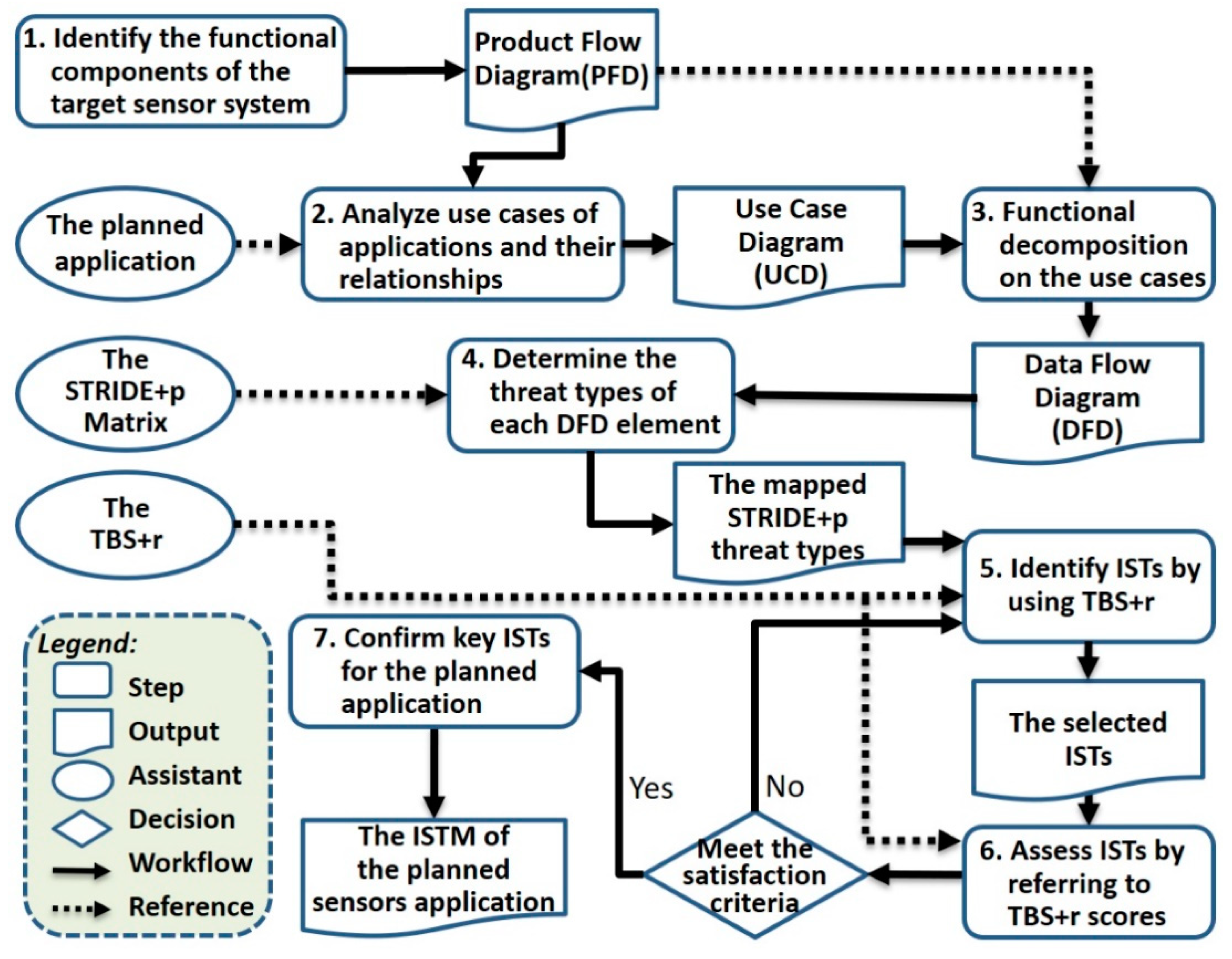
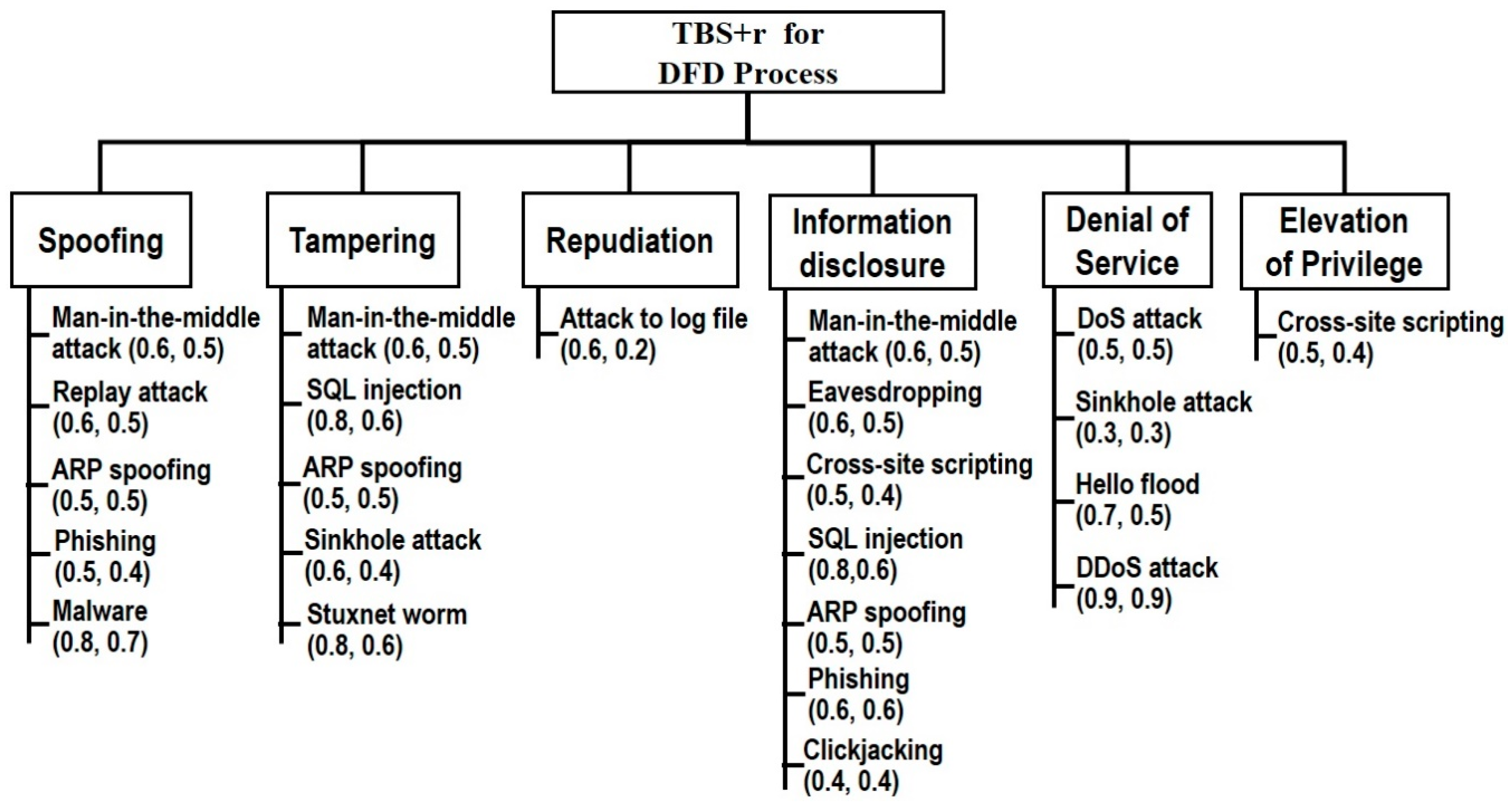
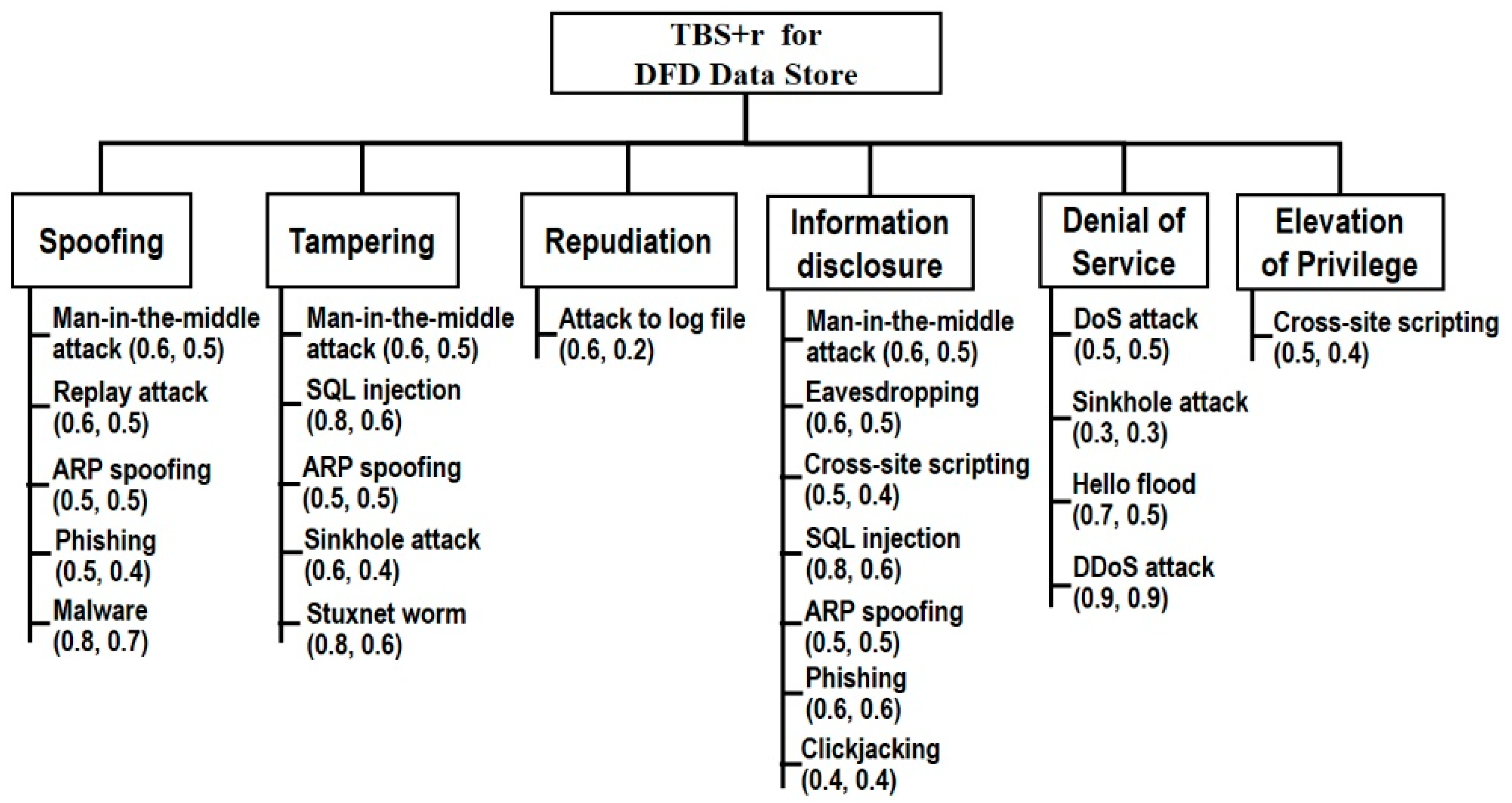
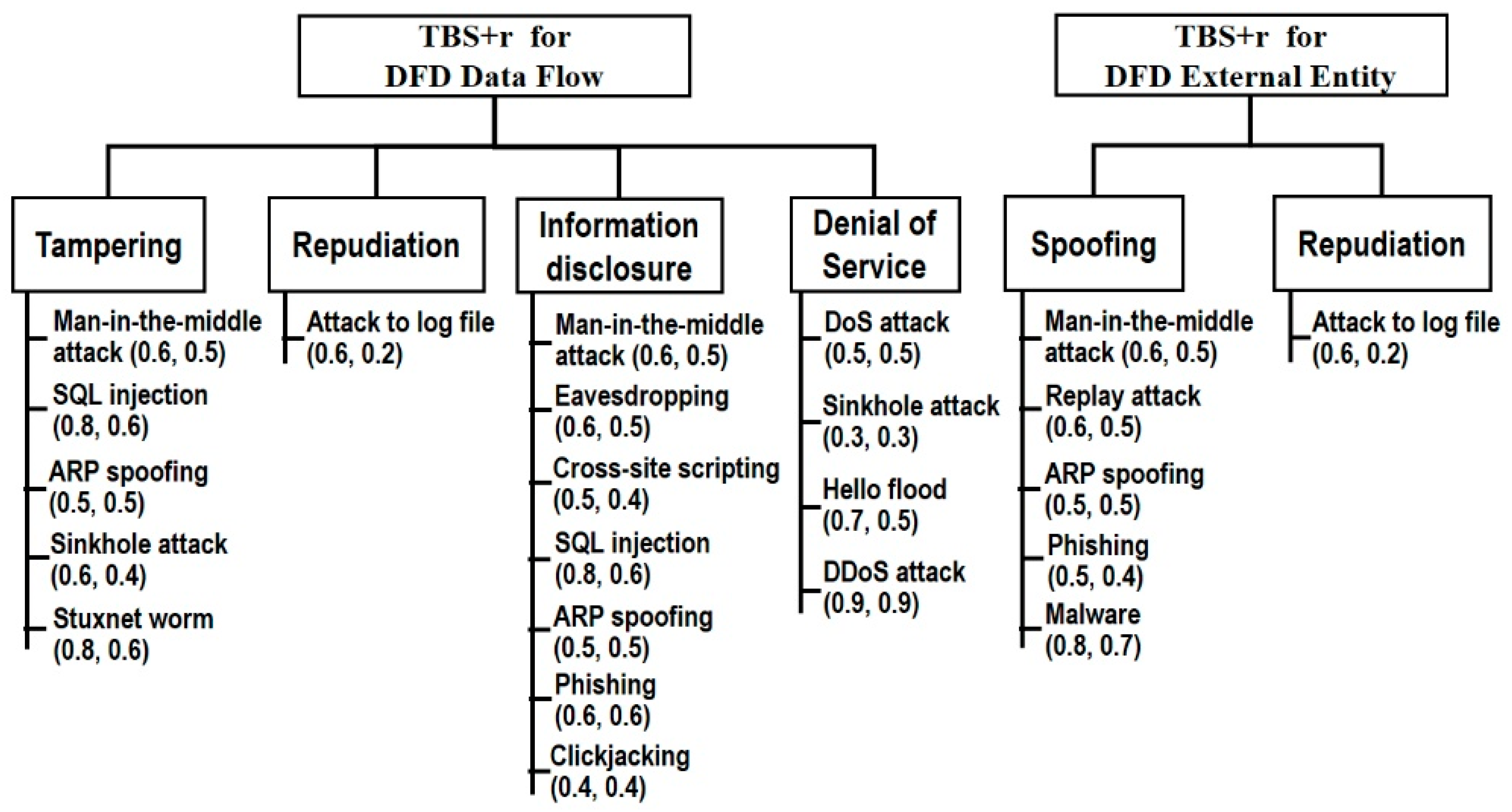
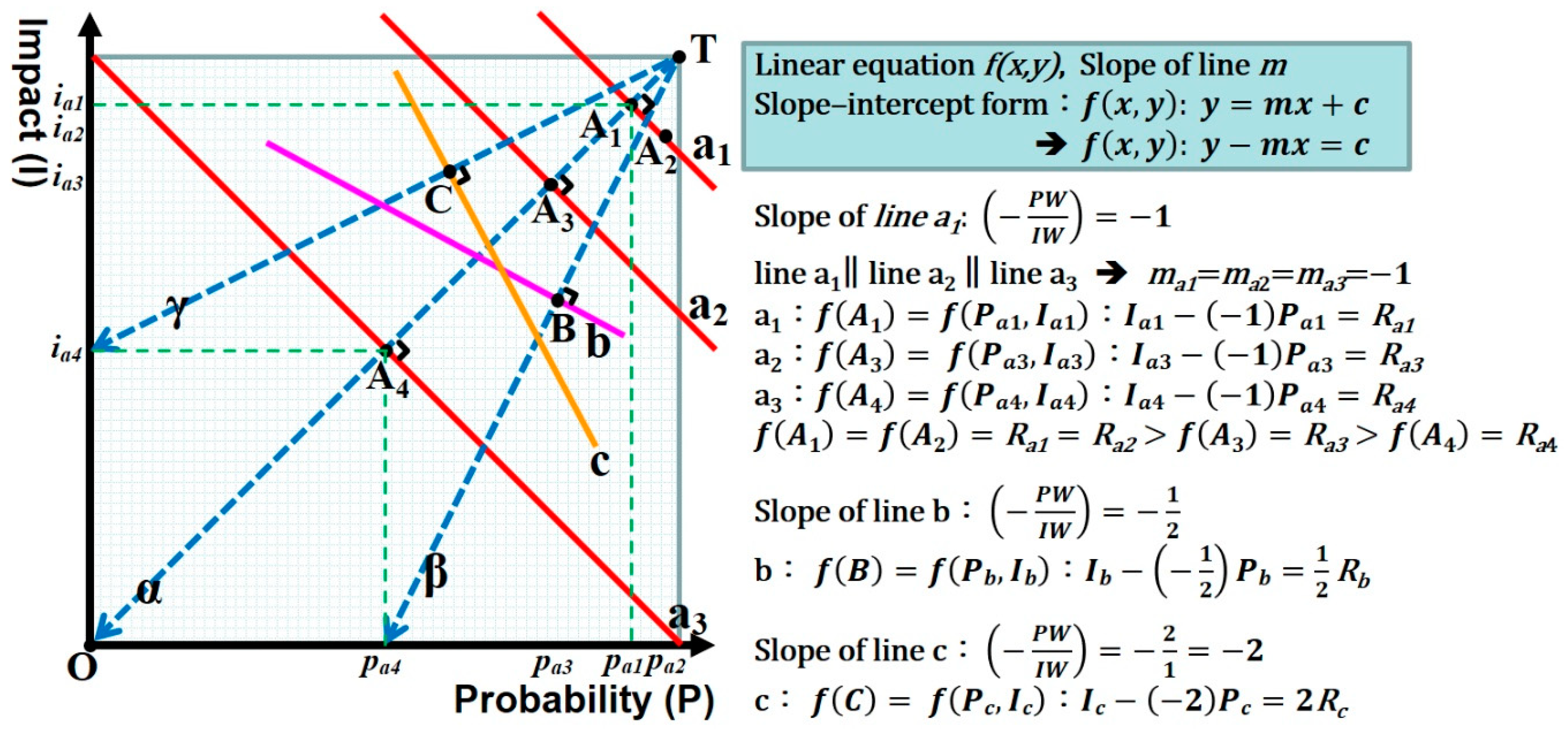
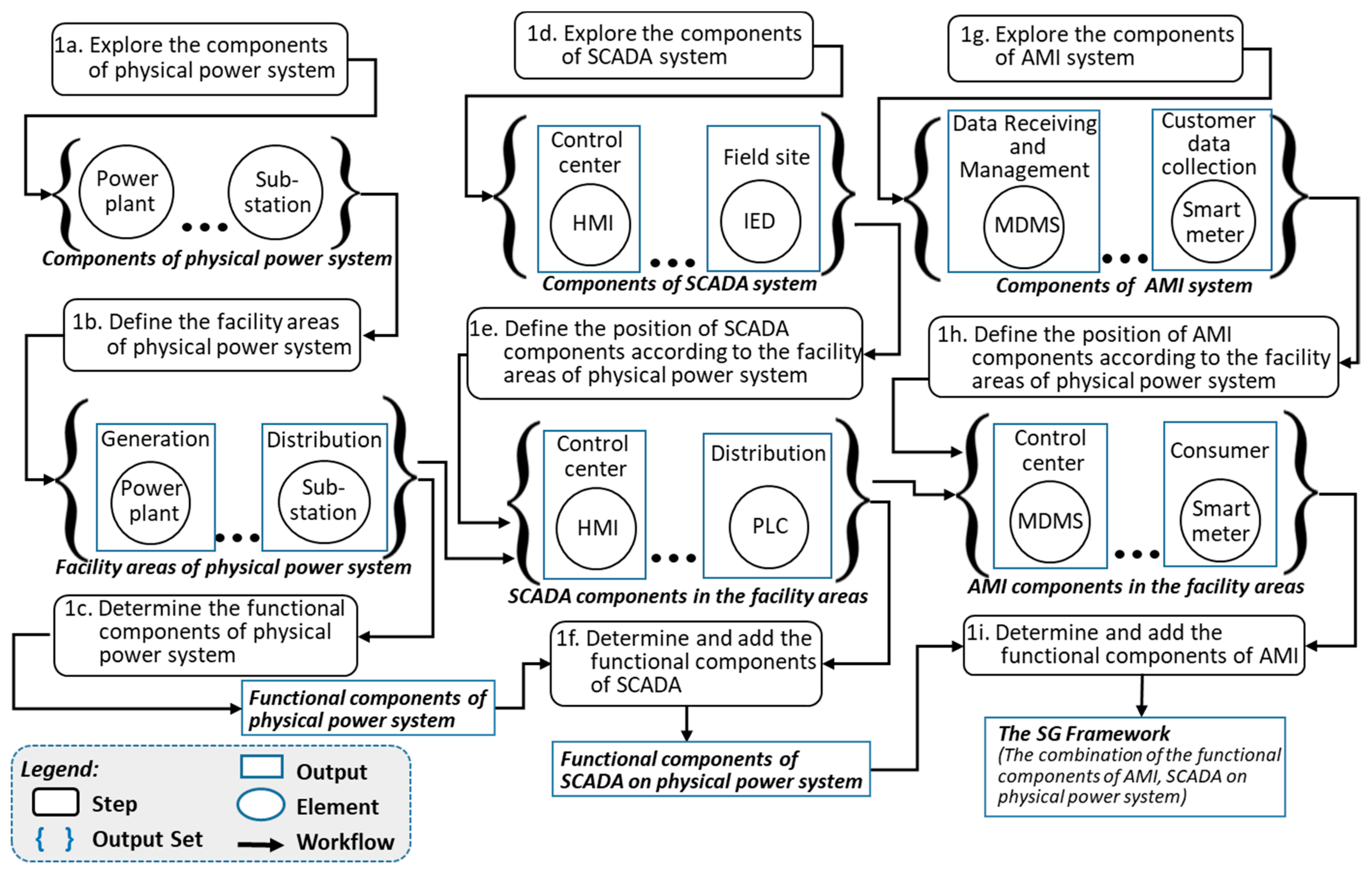
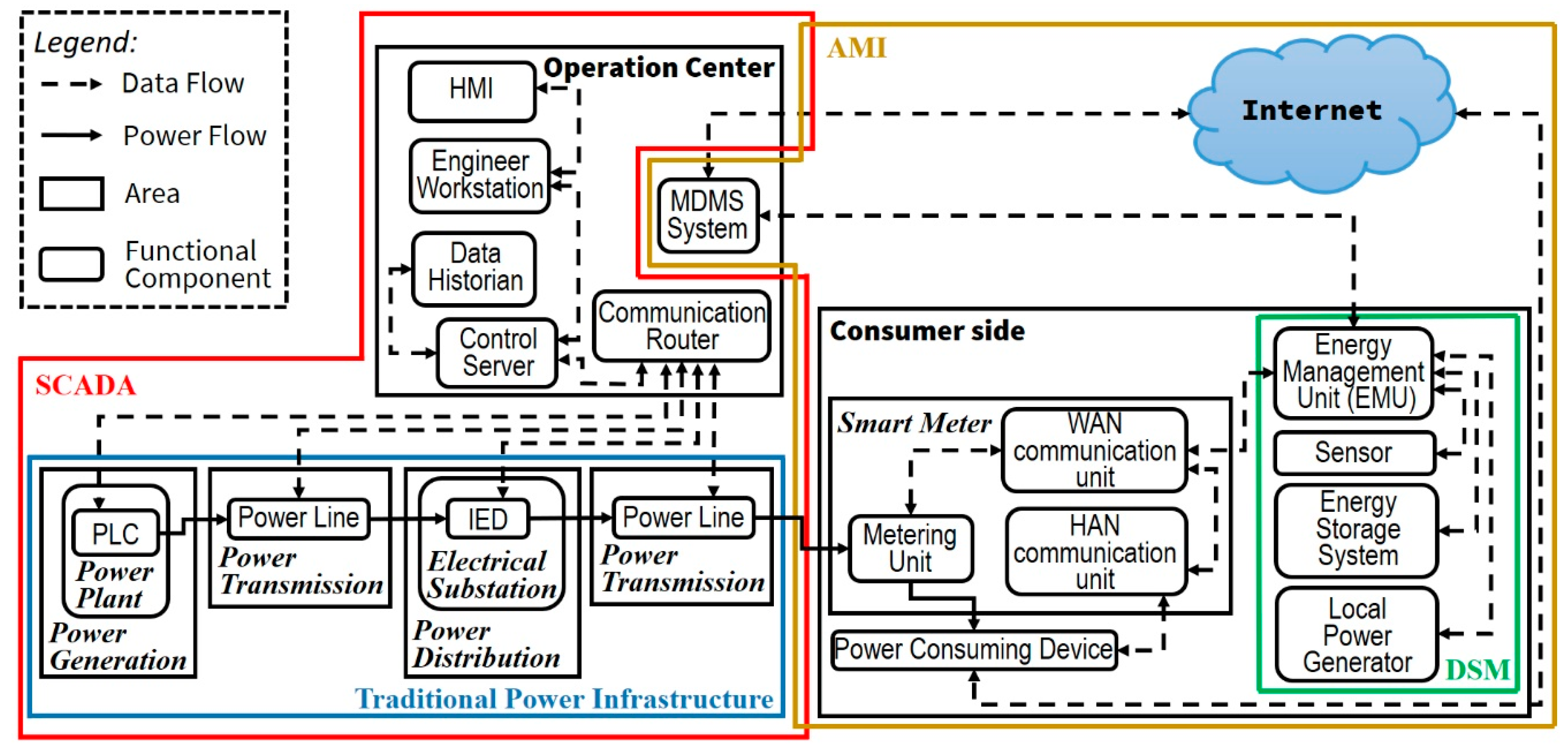
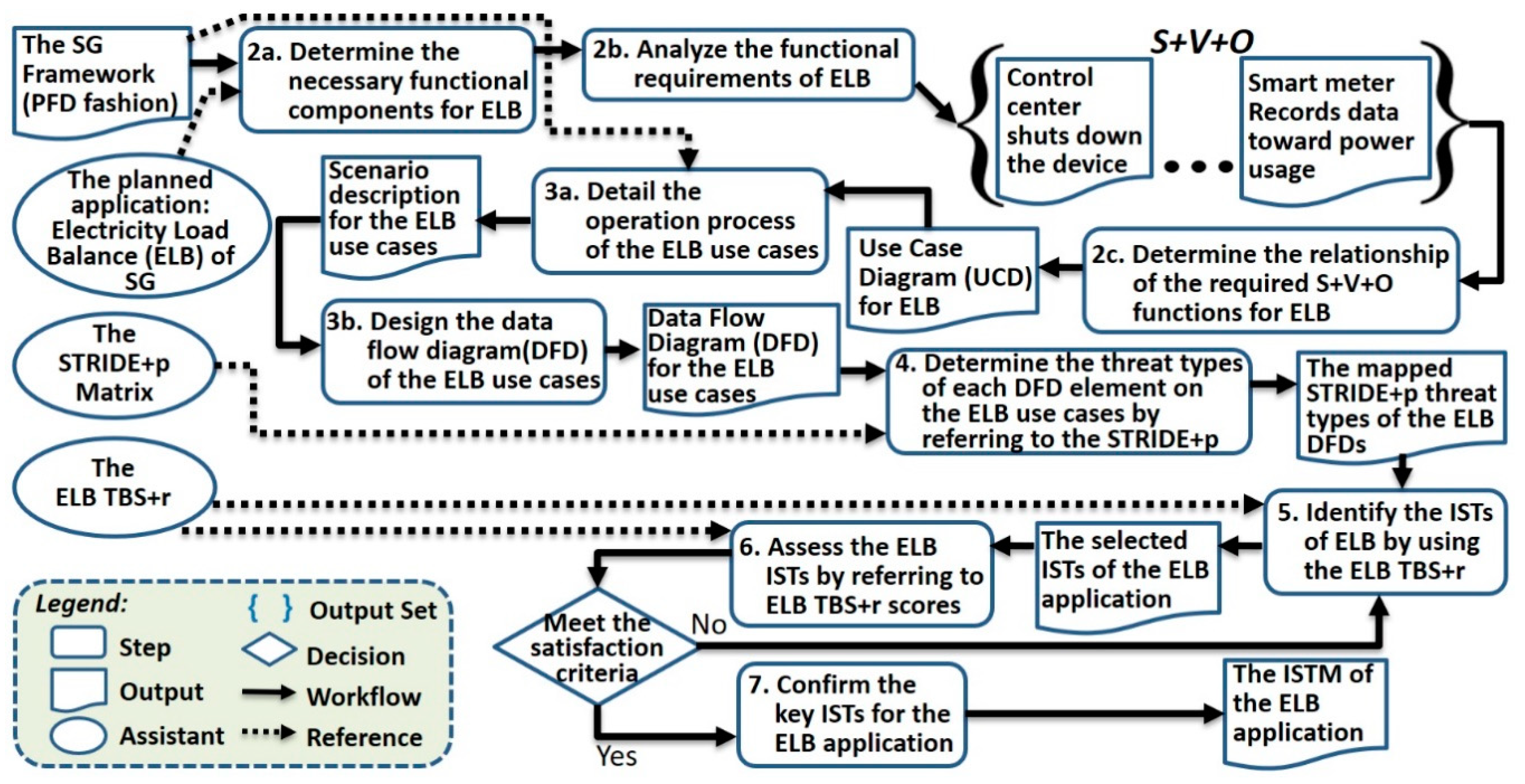
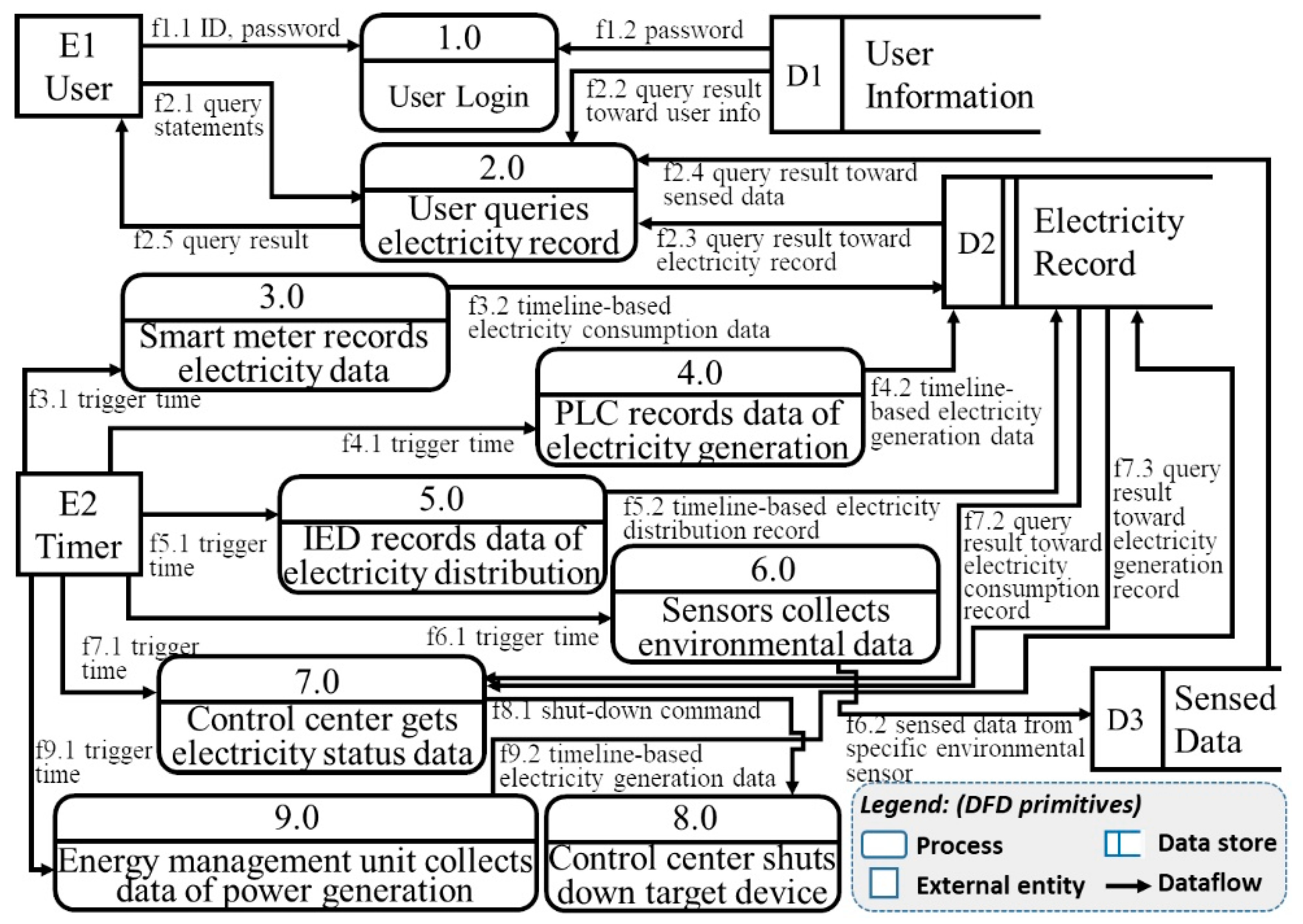
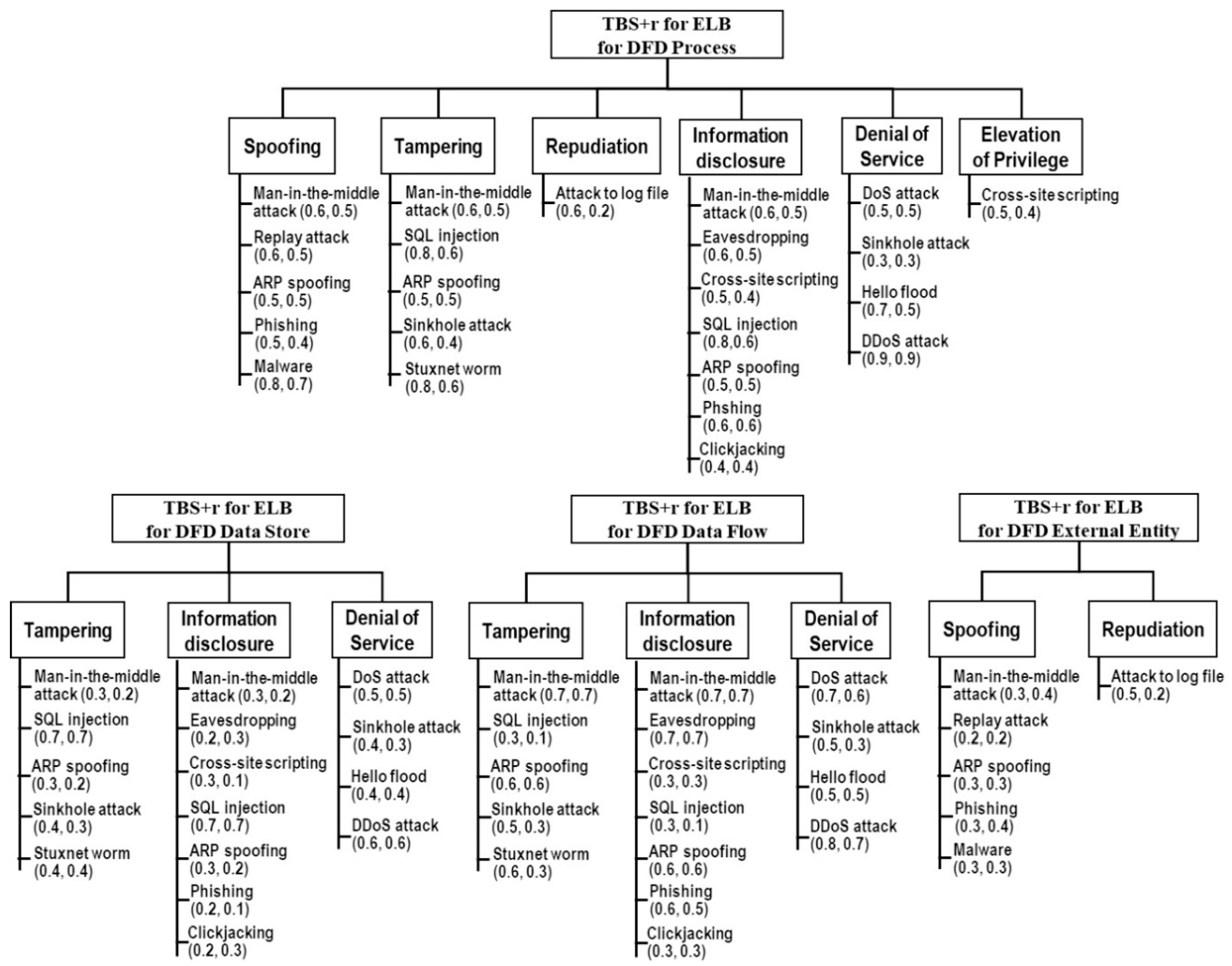
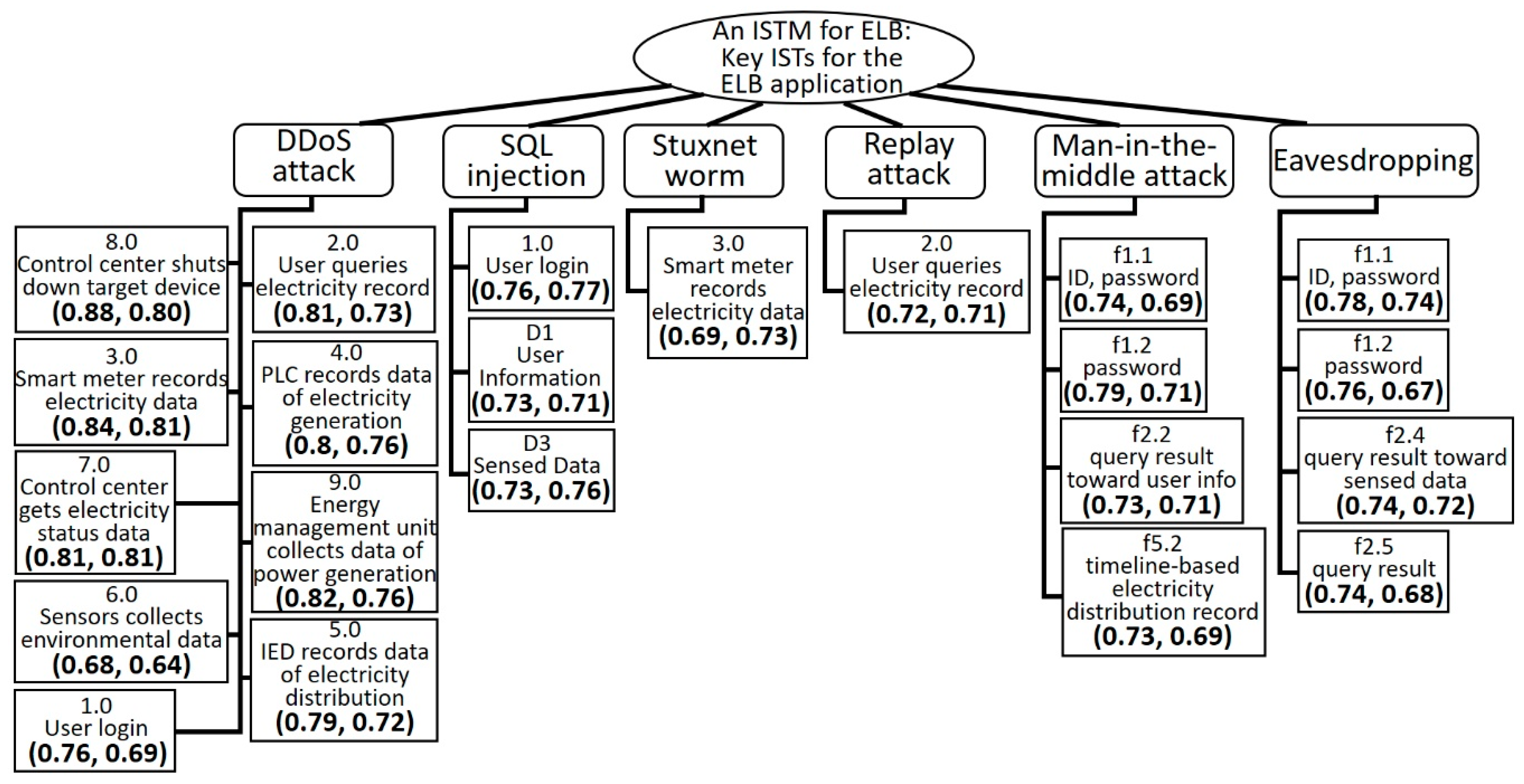
| Threat Type | STRIDE | LINDDUN | STRIDE+p | |||||||||||||||||
|---|---|---|---|---|---|---|---|---|---|---|---|---|---|---|---|---|---|---|---|---|
| DFD Element | S | T | R | I | D | E | L | I | N | D | D | U | N | S | T | R | I | D | E | |
| Process | √ | √ | √ | √ | √ | √ | √ | √ | √ | √ | √ | √ | √ | √ | √ | √ | √ | √ | ||
| Data Flow | √ | √ | √ | √ | √ | √ | √ | √ | √ | √ | √ | √ | √ | |||||||
| Data Store | √ | √ | √ | √ | √ | √ | √ | √ | √ | √ | √ | √ | √ | √ | √ | √ | ||||
| External Entity | √ | √ | √ | √ | √ | √ | √ | |||||||||||||
| RFD External Entity | E1 | E2 | |||
|---|---|---|---|---|---|
| IST | I | P | I | P | |
| Man-in-the-middle (MITM) attack | 0.71 | 0.64 | 0.33 | 0.22 | |
| Replay attack | 0.64 | 0.58 | 0.60 | 0.66 | |
| ARP spoofing | 0.33 | 0.30 | 0.73 | 0.66 | |
| Phishing | 0.68 | 0.66 | 0.38 | 0.27 | |
| Malware | 0.56 | 0.59 | 0.39 | 0.20 | |
| Attack to log file | 0.67 | 0.56 | 0.69 | 0.70 | |
| DFD Data Flow | f1.1 | f1.2 | f2.1 | f2.2 | f2.3 | f2.4 | f2.5 | ||||||||
| IST | I | P | I | P | I | P | I | P | I | P | I | P | I | P | |
| Man-in-the-middle (MITM) attack | 0.74 | 0.69 | 0.79 | 0.71 | 0.68 | 0.67 | 0.73 | 0.71 | 0.74 | 0.69 | 0.72 | 0.66 | 0.68 | 0.71 | |
| SQL injection | 0.31 | 0.17 | 0.49 | 0.44 | 0.26 | 0.19 | 0.51 | 0.47 | 0.31 | 0.17 | 0.46 | 0.43 | 0.37 | 0.28 | |
| ARP spoofing | 0.60 | 0.59 | 0.63 | 0.59 | 0.63 | 0.59 | 0.62 | 0.54 | 0.60 | 0.59 | 0.62 | 0.59 | 0.58 | 0.58 | |
| Sinkhole attack | 0.60 | 0.34 | 0.36 | 0.22 | 0.49 | 0.34 | 0.40 | 0.30 | 0.60 | 0.34 | 0.36 | 0.34 | 0.40 | 0.34 | |
| Stuxnet worm | 0.49 | 0.38 | 0.45 | 0.38 | 0.46 | 0.39 | 0.48 | 0.35 | 0.49 | 0.38 | 0.48 | 0.42 | 0.49 | 0.51 | |
| Eavesdropping | 0.78 | 0.74 | 0.76 | 0.67 | 0.64 | 0.58 | 0.70 | 0.64 | 0.78 | 0.74 | 0.74 | 0.72 | 0.74 | 0.68 | |
| Cross-site scripting | 0.23 | 0.26 | 0.26 | 0.28 | 0.29 | 0.20 | 0.28 | 0.20 | 0.23 | 0.26 | 0.32 | 0.24 | 0.28 | 0.22 | |
| Phishing | 0.48 | 0.45 | 0.48 | 0.46 | 0.34 | 0.28 | 0.29 | 0.28 | 0.48 | 0.45 | 0.34 | 0.36 | 0.34 | 0.34 | |
| Clickjacking | 0.27 | 0.20 | 0.29 | 0.30 | 0.25 | 0.28 | 0.49 | 0.43 | 0.27 | 0.20 | 0.46 | 0.41 | 0.52 | 0.46 | |
| DoS attack | 0.52 | 0.46 | 0.58 | 0.52 | 0.60 | 0.38 | 0.58 | 0.47 | 0.52 | 0.46 | 0.63 | 0.47 | 0.59 | 0.47 | |
| Hello flood | 0.28 | 0.26 | 0.49 | 0.33 | 0.29 | 0.22 | 0.29 | 0.28 | 0.28 | 0.26 | 0.29 | 0.32 | 0.29 | 0.24 | |
| DDoS attack | 0.63 | 0.59 | 0.67 | 0.60 | 0.67 | 0.47 | 0.59 | 0.55 | 0.63 | 0.59 | 0.63 | 0.54 | 0.63 | 0.54 | |
| Continuous | |||||||||||||||
| DFD Data Flow | f3.2 | f4.2 | f5.2 | f6.2 | f7.2 | f7.3 | f9.2 | ||||||||
| IST | I | P | I | P | I | P | I | P | I | P | I | P | I | P | |
| Man-in-the-middle (MITM) attack | 0.60 | 0.51 | 0.60 | 0.51 | 0.73 | 0.69 | 0.68 | 0.66 | 0.64 | 0.67 | 0.64 | 0.62 | 0.64 | 0.56 | |
| SQL injection | 0.31 | 0.20 | 0.31 | 0.20 | 0.45 | 0.36 | 0.43 | 0.37 | 0.38 | 0.41 | 0.44 | 0.35 | 0.44 | 0.43 | |
| ARP spoofing | 0.50 | 0.45 | 0.50 | 0.45 | 0.62 | 0.61 | 0.62 | 0.65 | 0.58 | 0.59 | 0.58 | 0.54 | 0.54 | 0.52 | |
| Sinkhole attack | 0.44 | 0.30 | 0.44 | 0.36 | 0.50 | 0.39 | 0.45 | 0.34 | 0.54 | 0.48 | 0.53 | 0.48 | 0.50 | 0.31 | |
| Stuxnet worm | 0.54 | 0.24 | 0.60 | 0.36 | 0.60 | 0.48 | 0.64 | 0.58 | 0.59 | 0.52 | 0.64 | 0.52 | 0.56 | 0.39 | |
| Eavesdropping | 0.65 | 0.60 | 0.51 | 0.55 | 0.66 | 0.64 | 0.66 | 0.68 | 0.43 | 0.48 | 0.43 | 0.48 | 0.32 | 0.42 | |
| Cross-site scripting | 0.25 | 0.25 | 0.25 | 0.25 | 0.26 | 0.26 | 0.22 | 0.22 | 0.19 | 0.20 | 0.19 | 0.20 | 0.22 | 0.18 | |
| Phishing | 0.50 | 0.39 | 0.36 | 0.30 | 0.31 | 0.22 | 0.24 | 0.22 | 0.25 | 0.32 | 0.25 | 0.32 | 0.46 | 0.26 | |
| Clickjacking | 0.35 | 0.25 | 0.35 | 0.25 | 0.24 | 0.20 | 0.22 | 0.18 | 0.22 | 0.24 | 0.26 | 0.28 | 0.24 | 0.21 | |
| DoS attack | 0.56 | 0.46 | 0.65 | 0.51 | 0.63 | 0.57 | 0.59 | 0.57 | 0.71 | 0.55 | 0.66 | 0.54 | 0.66 | 0.57 | |
| Hello flood | 0.50 | 0.45 | 0.55 | 0.45 | 0.38 | 0.32 | 0.34 | 0.35 | 0.42 | 0.36 | 0.46 | 0.44 | 0.36 | 0.31 | |
| DDoS attack | 0.71 | 0.65 | 0.75 | 0.61 | 0.68 | 0.67 | 0.73 | 0.67 | 0.74 | 0.65 | 0.70 | 0.61 | 0.72 | 0.63 | |
| DFD Data Store | D1 | D2 | D3 | ||||
|---|---|---|---|---|---|---|---|
| IST | I | P | I | P | I | P | |
| Man-in-the-middle (MITM) attack | 0.22 | 0.16 | 0.18 | 0.20 | 0.22 | 0.20 | |
| SQL injection | 0.73 | 0.71 | 0.68 | 0.67 | 0.73 | 0.76 | |
| ARP spoofing | 0.30 | 0.20 | 0.30 | 0.24 | 0.26 | 0.20 | |
| Sinkhole attack | 0.49 | 0.38 | 0.49 | 0.38 | 0.40 | 0.33 | |
| Stuxnet worm | 0.40 | 0.43 | 0.44 | 0.43 | 0.40 | 0.39 | |
| Eavesdropping | 0.20 | 0.22 | 0.20 | 0.22 | 0.16 | 0.18 | |
| Cross-site scripting | 0.22 | 0.12 | 0.13 | 0.12 | 0.18 | 0.16 | |
| Phishing | 0.44 | 0.48 | 0.52 | 0.48 | 0.41 | 0.36 | |
| Clickjacking | 0.20 | 0.22 | 0.20 | 0.22 | 0.16 | 0.17 | |
| DoS attack | 0.38 | 0.38 | 0.38 | 0.38 | 0.54 | 0.54 | |
| Hello flood | 0.32 | 0.28 | 0.31 | 0.27 | 0.31 | 0.27 | |
| DDoS attack | 0.64 | 0.64 | 0.55 | 0.64 | 0.64 | 0.64 | |
| DFD Process | 1.0 | 2.0 | 3.0 | 4.0 | 5.0 | 6.0 | 7.0 | 8.0 | 9.0 | ||||||||||
|---|---|---|---|---|---|---|---|---|---|---|---|---|---|---|---|---|---|---|---|
| IST | I | P | I | P | I | P | I | P | I | P | I | P | I | P | I | P | I | P | |
| MITM attack | 0.67 | 0.65 | 0.66 | 0.65 | 0.62 | 0.61 | 0.62 | 0.61 | 0.62 | 0.61 | 0.63 | 0.65 | 0.66 | 0.58 | 0.58 | 0.57 | 0.62 | 0.58 | |
| Replay attack | 0.72 | 0.67 | 0.72 | 0.71 | 0.64 | 0.66 | 0.60 | 0.67 | 0.64 | 0.62 | 0.64 | 0.62 | 0.60 | 0.58 | 0.56 | 0.58 | 0.62 | 0.66 | |
| ARP spoofing | 0.67 | 0.72 | 0.67 | 0.72 | 0.66 | 0.63 | 0.62 | 0.59 | 0.67 | 0.68 | 0.67 | 0.63 | 0.66 | 0.59 | 0.62 | 0.59 | 0.66 | 0.65 | |
| Phishing | 0.38 | 0.34 | 0.42 | 0.34 | 0.22 | 0.18 | 0.22 | 0.19 | 0.26 | 0.26 | 0.34 | 0.29 | 0.22 | 0.22 | 0.27 | 0.22 | 0.26 | 0.24 | |
| Malware | 0.35 | 0.38 | 0.35 | 0.38 | 0.22 | 0.21 | 0.27 | 0.25 | 0.27 | 0.33 | 0.31 | 0.25 | 0.22 | 0.25 | 0.23 | 0.21 | 0.23 | 0.26 | |
| SQL injection | 0.76 | 0.77 | 0.71 | 0.73 | 0.65 | 0.60 | 0.62 | 0.57 | 0.58 | 0.52 | 0.51 | 0.52 | 0.65 | 0.62 | 0.62 | 0.60 | 0.58 | 0.52 | |
| Sinkhole attack | 0.45 | 0.41 | 0.45 | 0.39 | 0.51 | 0.49 | 0.49 | 0.45 | 0.49 | 0.44 | 0.49 | 0.45 | 0.49 | 0.49 | 0.50 | 0.49 | 0.51 | 0.45 | |
| Stuxnet worm | 0.53 | 0.51 | 0.53 | 0.46 | 0.69 | 0.73 | 0.64 | 0.61 | 0.69 | 0.62 | 0.64 | 0.62 | 0.64 | 0.58 | 0.60 | 0.58 | 0.71 | 0.63 | |
| Attack to log file | 0.27 | 0.18 | 0.31 | 0.23 | 0.44 | 0.45 | 0.41 | 0.36 | 0.42 | 0.44 | 0.48 | 0.38 | 0.43 | 0.40 | 0.45 | 0.36 | 0.41 | 0.33 | |
| Eavesdropping | 0.58 | 0.56 | 0.58 | 0.52 | 0.62 | 0.52 | 0.57 | 0.44 | 0.62 | 0.39 | 0.58 | 0.51 | 0.58 | 0.44 | 0.54 | 0.40 | 0.64 | 0.42 | |
| Cross-site scripting | 0.42 | 0.40 | 0.41 | 0.39 | 0.25 | 0.24 | 0.21 | 0.18 | 0.25 | 0.24 | 0.25 | 0.24 | 0.25 | 0.19 | 0.25 | 0.19 | 0.25 | 0.17 | |
| Click-jacking | 0.40 | 0.42 | 0.44 | 0.42 | 0.23 | 0.18 | 0.28 | 0.26 | 0.32 | 0.22 | 0.32 | 0.31 | 0.24 | 0.17 | 0.19 | 0.22 | 0.21 | 0.23 | |
| DoS attack | 0.56 | 0.58 | 0.64 | 0.58 | 0.60 | 0.66 | 0.56 | 0.58 | 0.64 | 0.66 | 0.64 | 0.62 | 0.56 | 0.62 | 0.60 | 0.58 | 0.58 | 0.70 | |
| Hello flood | 0.31 | 0.34 | 0.35 | 0.38 | 0.35 | 0.37 | 0.37 | 0.39 | 0.34 | 0.37 | 0.34 | 0.38 | 0.38 | 0.37 | 0.39 | 0.42 | 0.34 | 0.30 | |
| DDoS attack | 0.76 | 0.69 | 0.81 | 0.73 | 0.84 | 0.81 | 0.80 | 0.76 | 0.79 | 0.72 | 0.68 | 0.64 | 0.81 | 0.81 | 0.88 | 0.80 | 0.82 | 0.76 | |
© 2019 by the authors. Licensee MDPI, Basel, Switzerland. This article is an open access article distributed under the terms and conditions of the Creative Commons Attribution (CC BY) license (http://creativecommons.org/licenses/by/4.0/).
Share and Cite
Chen, Y.-T.; Huang, C.-C. Determining Information Security Threats for an IoT-Based Energy Internet by Adopting Software Engineering and Risk Management Approaches. Inventions 2019, 4, 53. https://doi.org/10.3390/inventions4030053
Chen Y-T, Huang C-C. Determining Information Security Threats for an IoT-Based Energy Internet by Adopting Software Engineering and Risk Management Approaches. Inventions. 2019; 4(3):53. https://doi.org/10.3390/inventions4030053
Chicago/Turabian StyleChen, Yu-Tso, and Chuang-Chiao Huang. 2019. "Determining Information Security Threats for an IoT-Based Energy Internet by Adopting Software Engineering and Risk Management Approaches" Inventions 4, no. 3: 53. https://doi.org/10.3390/inventions4030053
APA StyleChen, Y.-T., & Huang, C.-C. (2019). Determining Information Security Threats for an IoT-Based Energy Internet by Adopting Software Engineering and Risk Management Approaches. Inventions, 4(3), 53. https://doi.org/10.3390/inventions4030053




